Depression and Anxiety in Australia: Statistics, Causes, and Impact
VerifiedAdded on 2023/03/31
|6
|1321
|119
AI Summary
This article discusses the statistics, causes, and impact of depression and anxiety in Australia. It highlights the prevalence of these mental health disorders, the factors contributing to their occurrence, and the effects on individuals and society. The article emphasizes the importance of treatment, awareness, and support in overcoming these challenges.
Contribute Materials
Your contribution can guide someone’s learning journey. Share your
documents today.
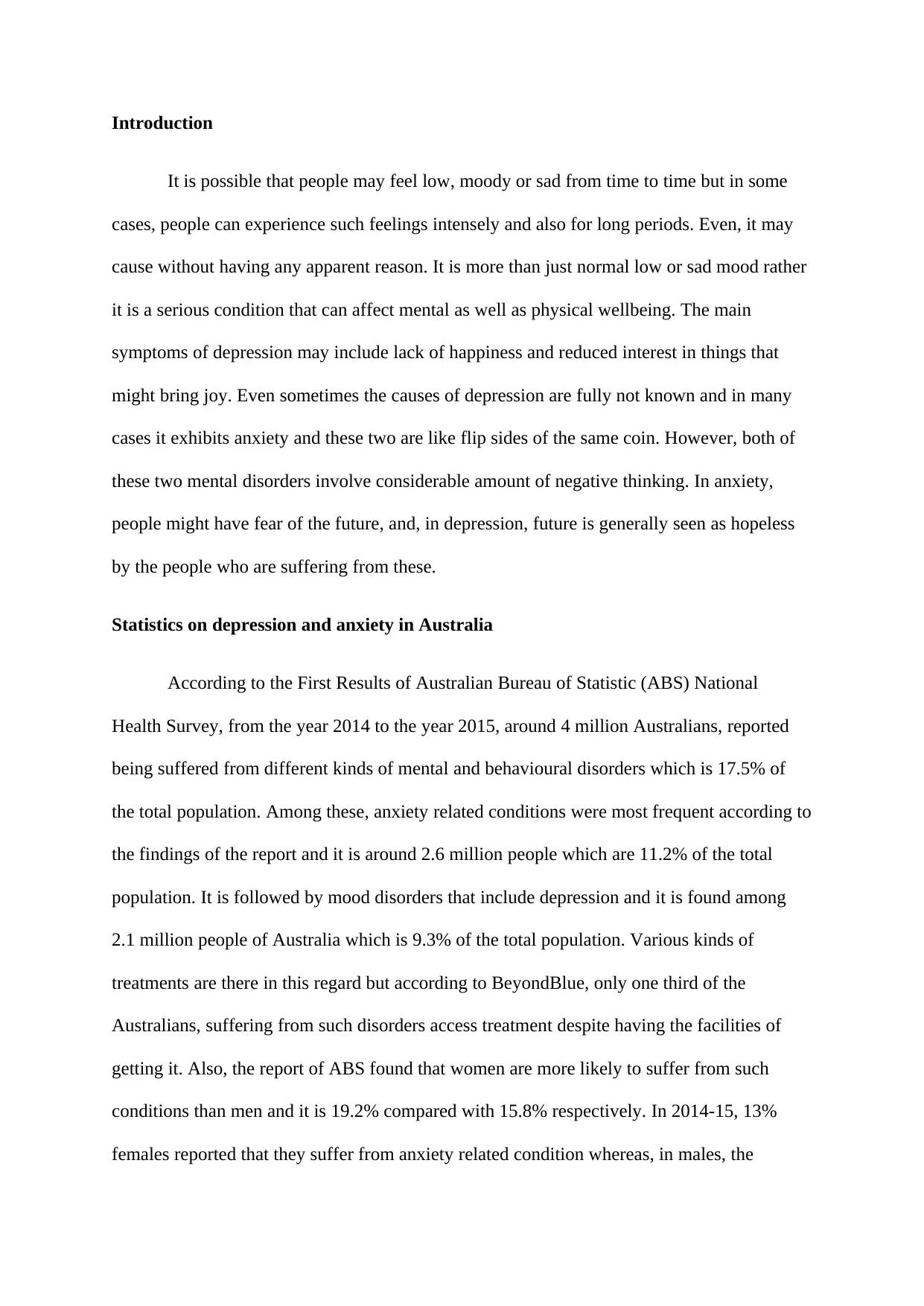
Introduction
It is possible that people may feel low, moody or sad from time to time but in some
cases, people can experience such feelings intensely and also for long periods. Even, it may
cause without having any apparent reason. It is more than just normal low or sad mood rather
it is a serious condition that can affect mental as well as physical wellbeing. The main
symptoms of depression may include lack of happiness and reduced interest in things that
might bring joy. Even sometimes the causes of depression are fully not known and in many
cases it exhibits anxiety and these two are like flip sides of the same coin. However, both of
these two mental disorders involve considerable amount of negative thinking. In anxiety,
people might have fear of the future, and, in depression, future is generally seen as hopeless
by the people who are suffering from these.
Statistics on depression and anxiety in Australia
According to the First Results of Australian Bureau of Statistic (ABS) National
Health Survey, from the year 2014 to the year 2015, around 4 million Australians, reported
being suffered from different kinds of mental and behavioural disorders which is 17.5% of
the total population. Among these, anxiety related conditions were most frequent according to
the findings of the report and it is around 2.6 million people which are 11.2% of the total
population. It is followed by mood disorders that include depression and it is found among
2.1 million people of Australia which is 9.3% of the total population. Various kinds of
treatments are there in this regard but according to BeyondBlue, only one third of the
Australians, suffering from such disorders access treatment despite having the facilities of
getting it. Also, the report of ABS found that women are more likely to suffer from such
conditions than men and it is 19.2% compared with 15.8% respectively. In 2014-15, 13%
females reported that they suffer from anxiety related condition whereas, in males, the
It is possible that people may feel low, moody or sad from time to time but in some
cases, people can experience such feelings intensely and also for long periods. Even, it may
cause without having any apparent reason. It is more than just normal low or sad mood rather
it is a serious condition that can affect mental as well as physical wellbeing. The main
symptoms of depression may include lack of happiness and reduced interest in things that
might bring joy. Even sometimes the causes of depression are fully not known and in many
cases it exhibits anxiety and these two are like flip sides of the same coin. However, both of
these two mental disorders involve considerable amount of negative thinking. In anxiety,
people might have fear of the future, and, in depression, future is generally seen as hopeless
by the people who are suffering from these.
Statistics on depression and anxiety in Australia
According to the First Results of Australian Bureau of Statistic (ABS) National
Health Survey, from the year 2014 to the year 2015, around 4 million Australians, reported
being suffered from different kinds of mental and behavioural disorders which is 17.5% of
the total population. Among these, anxiety related conditions were most frequent according to
the findings of the report and it is around 2.6 million people which are 11.2% of the total
population. It is followed by mood disorders that include depression and it is found among
2.1 million people of Australia which is 9.3% of the total population. Various kinds of
treatments are there in this regard but according to BeyondBlue, only one third of the
Australians, suffering from such disorders access treatment despite having the facilities of
getting it. Also, the report of ABS found that women are more likely to suffer from such
conditions than men and it is 19.2% compared with 15.8% respectively. In 2014-15, 13%
females reported that they suffer from anxiety related condition whereas, in males, the
Secure Best Marks with AI Grader
Need help grading? Try our AI Grader for instant feedback on your assignments.
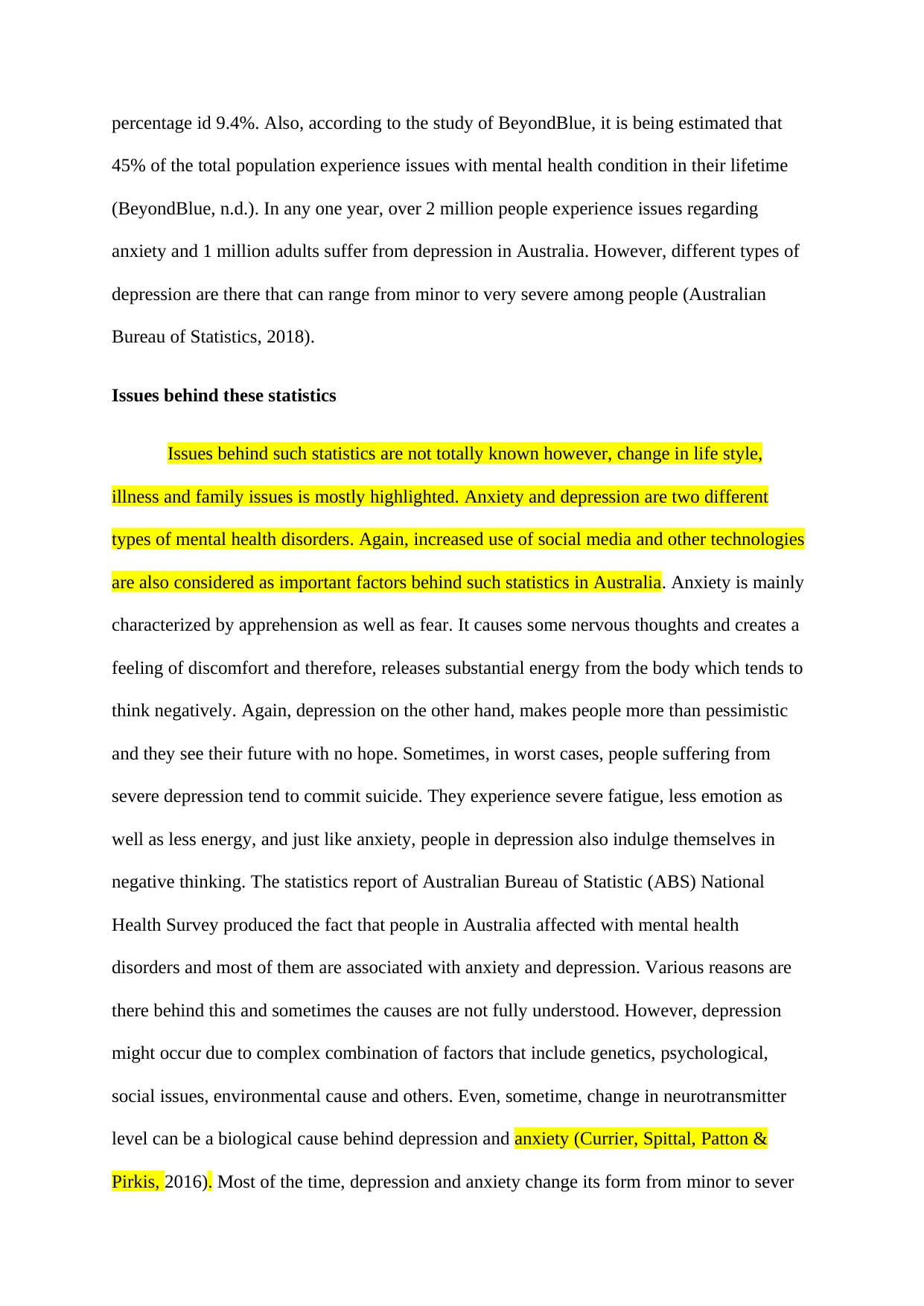
percentage id 9.4%. Also, according to the study of BeyondBlue, it is being estimated that
45% of the total population experience issues with mental health condition in their lifetime
(BeyondBlue, n.d.). In any one year, over 2 million people experience issues regarding
anxiety and 1 million adults suffer from depression in Australia. However, different types of
depression are there that can range from minor to very severe among people (Australian
Bureau of Statistics, 2018).
Issues behind these statistics
Issues behind such statistics are not totally known however, change in life style,
illness and family issues is mostly highlighted. Anxiety and depression are two different
types of mental health disorders. Again, increased use of social media and other technologies
are also considered as important factors behind such statistics in Australia. Anxiety is mainly
characterized by apprehension as well as fear. It causes some nervous thoughts and creates a
feeling of discomfort and therefore, releases substantial energy from the body which tends to
think negatively. Again, depression on the other hand, makes people more than pessimistic
and they see their future with no hope. Sometimes, in worst cases, people suffering from
severe depression tend to commit suicide. They experience severe fatigue, less emotion as
well as less energy, and just like anxiety, people in depression also indulge themselves in
negative thinking. The statistics report of Australian Bureau of Statistic (ABS) National
Health Survey produced the fact that people in Australia affected with mental health
disorders and most of them are associated with anxiety and depression. Various reasons are
there behind this and sometimes the causes are not fully understood. However, depression
might occur due to complex combination of factors that include genetics, psychological,
social issues, environmental cause and others. Even, sometime, change in neurotransmitter
level can be a biological cause behind depression and anxiety (Currier, Spittal, Patton &
Pirkis, 2016). Most of the time, depression and anxiety change its form from minor to sever
45% of the total population experience issues with mental health condition in their lifetime
(BeyondBlue, n.d.). In any one year, over 2 million people experience issues regarding
anxiety and 1 million adults suffer from depression in Australia. However, different types of
depression are there that can range from minor to very severe among people (Australian
Bureau of Statistics, 2018).
Issues behind these statistics
Issues behind such statistics are not totally known however, change in life style,
illness and family issues is mostly highlighted. Anxiety and depression are two different
types of mental health disorders. Again, increased use of social media and other technologies
are also considered as important factors behind such statistics in Australia. Anxiety is mainly
characterized by apprehension as well as fear. It causes some nervous thoughts and creates a
feeling of discomfort and therefore, releases substantial energy from the body which tends to
think negatively. Again, depression on the other hand, makes people more than pessimistic
and they see their future with no hope. Sometimes, in worst cases, people suffering from
severe depression tend to commit suicide. They experience severe fatigue, less emotion as
well as less energy, and just like anxiety, people in depression also indulge themselves in
negative thinking. The statistics report of Australian Bureau of Statistic (ABS) National
Health Survey produced the fact that people in Australia affected with mental health
disorders and most of them are associated with anxiety and depression. Various reasons are
there behind this and sometimes the causes are not fully understood. However, depression
might occur due to complex combination of factors that include genetics, psychological,
social issues, environmental cause and others. Even, sometime, change in neurotransmitter
level can be a biological cause behind depression and anxiety (Currier, Spittal, Patton &
Pirkis, 2016). Most of the time, depression and anxiety change its form from minor to sever
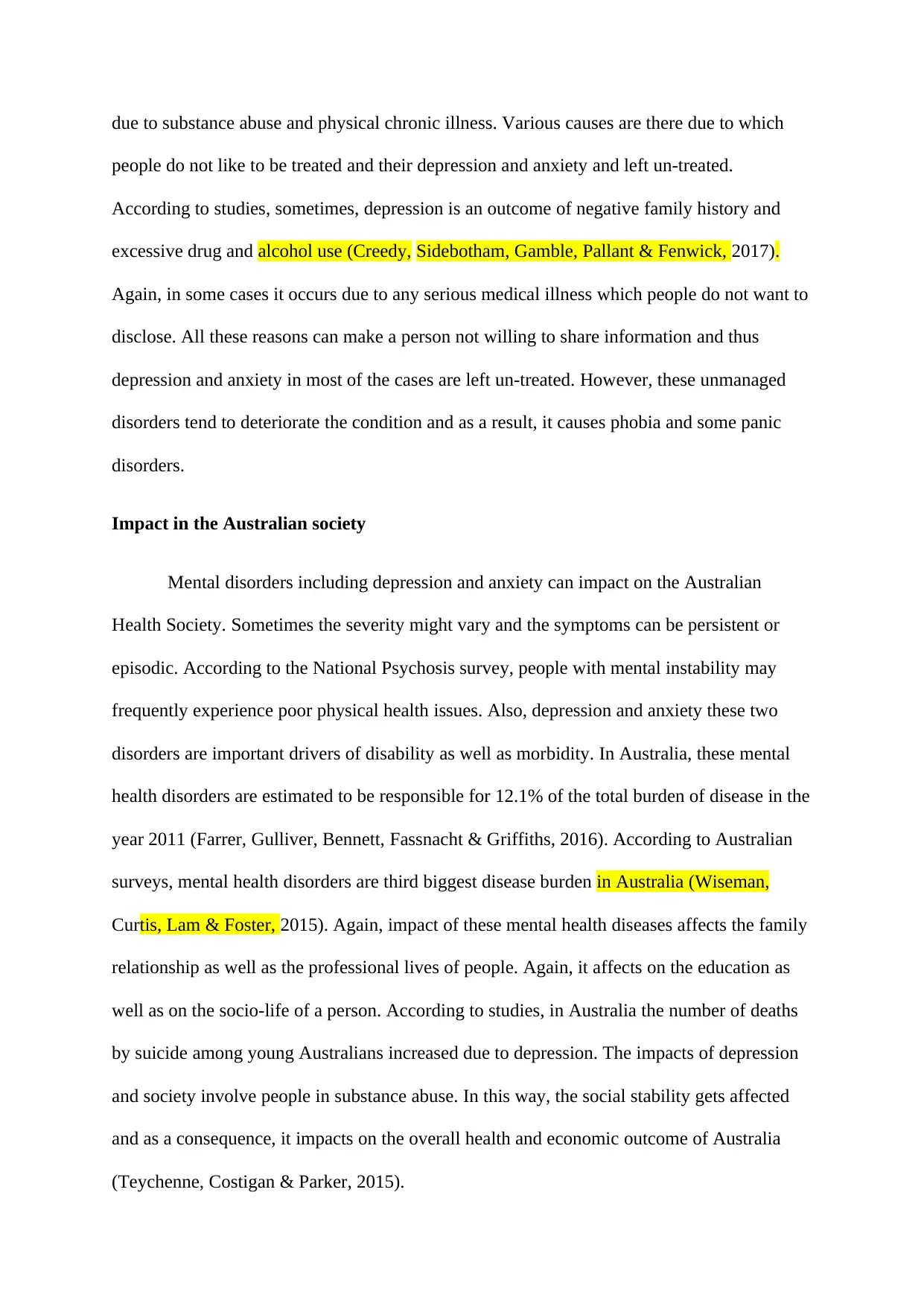
due to substance abuse and physical chronic illness. Various causes are there due to which
people do not like to be treated and their depression and anxiety and left un-treated.
According to studies, sometimes, depression is an outcome of negative family history and
excessive drug and alcohol use (Creedy, Sidebotham, Gamble, Pallant & Fenwick, 2017).
Again, in some cases it occurs due to any serious medical illness which people do not want to
disclose. All these reasons can make a person not willing to share information and thus
depression and anxiety in most of the cases are left un-treated. However, these unmanaged
disorders tend to deteriorate the condition and as a result, it causes phobia and some panic
disorders.
Impact in the Australian society
Mental disorders including depression and anxiety can impact on the Australian
Health Society. Sometimes the severity might vary and the symptoms can be persistent or
episodic. According to the National Psychosis survey, people with mental instability may
frequently experience poor physical health issues. Also, depression and anxiety these two
disorders are important drivers of disability as well as morbidity. In Australia, these mental
health disorders are estimated to be responsible for 12.1% of the total burden of disease in the
year 2011 (Farrer, Gulliver, Bennett, Fassnacht & Griffiths, 2016). According to Australian
surveys, mental health disorders are third biggest disease burden in Australia (Wiseman,
Curtis, Lam & Foster, 2015). Again, impact of these mental health diseases affects the family
relationship as well as the professional lives of people. Again, it affects on the education as
well as on the socio-life of a person. According to studies, in Australia the number of deaths
by suicide among young Australians increased due to depression. The impacts of depression
and society involve people in substance abuse. In this way, the social stability gets affected
and as a consequence, it impacts on the overall health and economic outcome of Australia
(Teychenne, Costigan & Parker, 2015).
people do not like to be treated and their depression and anxiety and left un-treated.
According to studies, sometimes, depression is an outcome of negative family history and
excessive drug and alcohol use (Creedy, Sidebotham, Gamble, Pallant & Fenwick, 2017).
Again, in some cases it occurs due to any serious medical illness which people do not want to
disclose. All these reasons can make a person not willing to share information and thus
depression and anxiety in most of the cases are left un-treated. However, these unmanaged
disorders tend to deteriorate the condition and as a result, it causes phobia and some panic
disorders.
Impact in the Australian society
Mental disorders including depression and anxiety can impact on the Australian
Health Society. Sometimes the severity might vary and the symptoms can be persistent or
episodic. According to the National Psychosis survey, people with mental instability may
frequently experience poor physical health issues. Also, depression and anxiety these two
disorders are important drivers of disability as well as morbidity. In Australia, these mental
health disorders are estimated to be responsible for 12.1% of the total burden of disease in the
year 2011 (Farrer, Gulliver, Bennett, Fassnacht & Griffiths, 2016). According to Australian
surveys, mental health disorders are third biggest disease burden in Australia (Wiseman,
Curtis, Lam & Foster, 2015). Again, impact of these mental health diseases affects the family
relationship as well as the professional lives of people. Again, it affects on the education as
well as on the socio-life of a person. According to studies, in Australia the number of deaths
by suicide among young Australians increased due to depression. The impacts of depression
and society involve people in substance abuse. In this way, the social stability gets affected
and as a consequence, it impacts on the overall health and economic outcome of Australia
(Teychenne, Costigan & Parker, 2015).
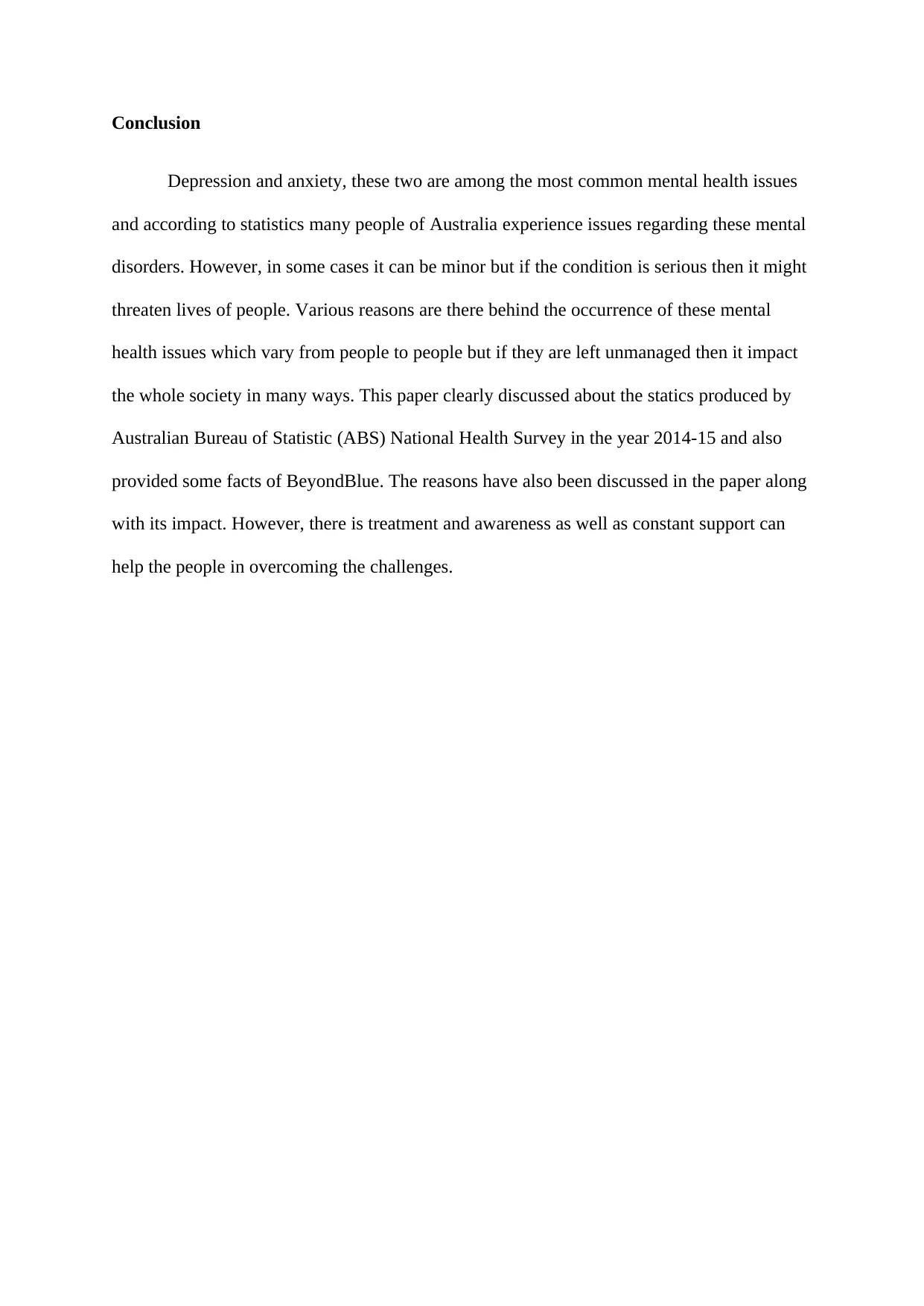
Conclusion
Depression and anxiety, these two are among the most common mental health issues
and according to statistics many people of Australia experience issues regarding these mental
disorders. However, in some cases it can be minor but if the condition is serious then it might
threaten lives of people. Various reasons are there behind the occurrence of these mental
health issues which vary from people to people but if they are left unmanaged then it impact
the whole society in many ways. This paper clearly discussed about the statics produced by
Australian Bureau of Statistic (ABS) National Health Survey in the year 2014-15 and also
provided some facts of BeyondBlue. The reasons have also been discussed in the paper along
with its impact. However, there is treatment and awareness as well as constant support can
help the people in overcoming the challenges.
Depression and anxiety, these two are among the most common mental health issues
and according to statistics many people of Australia experience issues regarding these mental
disorders. However, in some cases it can be minor but if the condition is serious then it might
threaten lives of people. Various reasons are there behind the occurrence of these mental
health issues which vary from people to people but if they are left unmanaged then it impact
the whole society in many ways. This paper clearly discussed about the statics produced by
Australian Bureau of Statistic (ABS) National Health Survey in the year 2014-15 and also
provided some facts of BeyondBlue. The reasons have also been discussed in the paper along
with its impact. However, there is treatment and awareness as well as constant support can
help the people in overcoming the challenges.
Secure Best Marks with AI Grader
Need help grading? Try our AI Grader for instant feedback on your assignments.
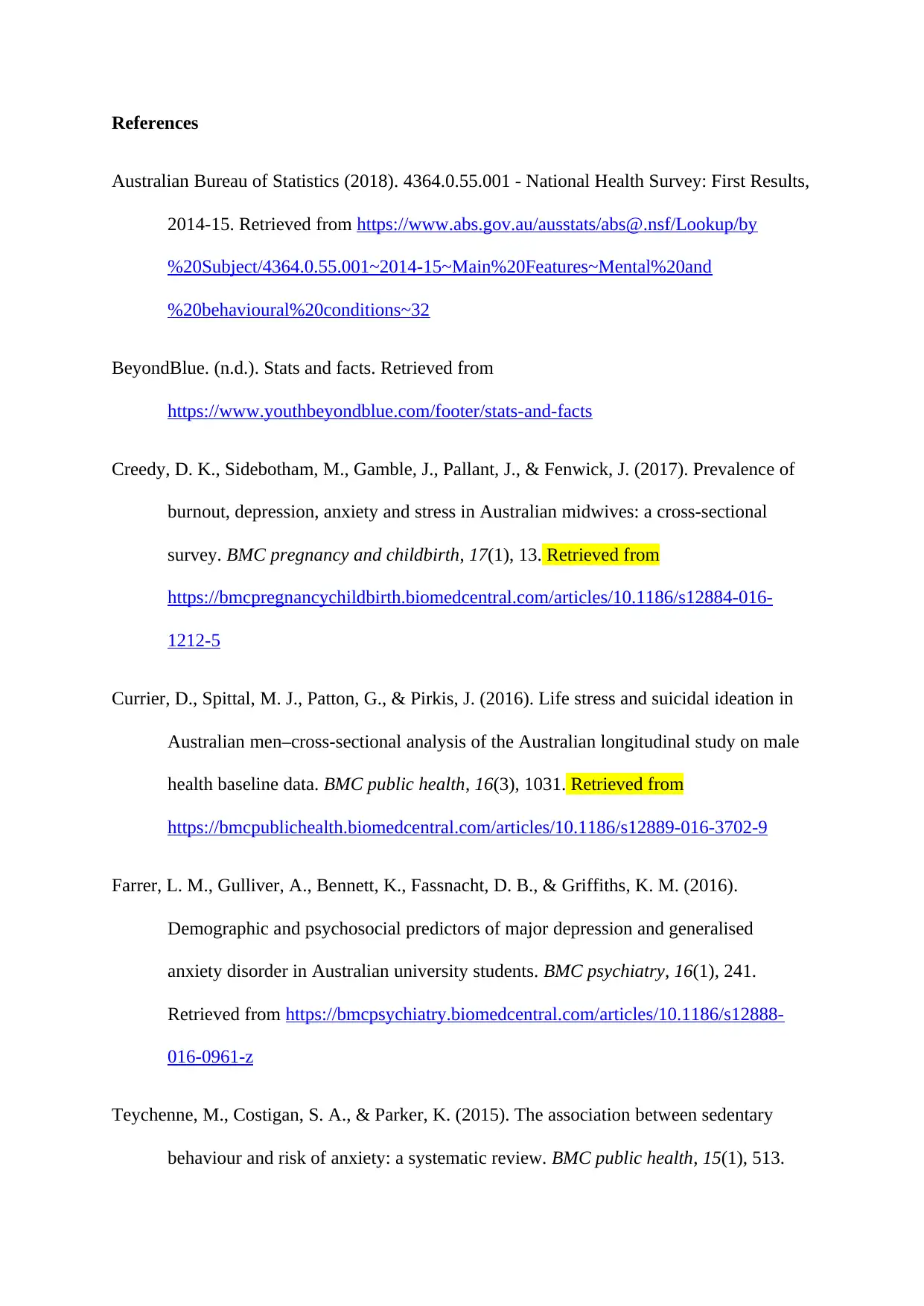
References
Australian Bureau of Statistics (2018). 4364.0.55.001 - National Health Survey: First Results,
2014-15. Retrieved from https://www.abs.gov.au/ausstats/abs@.nsf/Lookup/by
%20Subject/4364.0.55.001~2014-15~Main%20Features~Mental%20and
%20behavioural%20conditions~32
BeyondBlue. (n.d.). Stats and facts. Retrieved from
https://www.youthbeyondblue.com/footer/stats-and-facts
Creedy, D. K., Sidebotham, M., Gamble, J., Pallant, J., & Fenwick, J. (2017). Prevalence of
burnout, depression, anxiety and stress in Australian midwives: a cross-sectional
survey. BMC pregnancy and childbirth, 17(1), 13. Retrieved from
https://bmcpregnancychildbirth.biomedcentral.com/articles/10.1186/s12884-016-
1212-5
Currier, D., Spittal, M. J., Patton, G., & Pirkis, J. (2016). Life stress and suicidal ideation in
Australian men–cross-sectional analysis of the Australian longitudinal study on male
health baseline data. BMC public health, 16(3), 1031. Retrieved from
https://bmcpublichealth.biomedcentral.com/articles/10.1186/s12889-016-3702-9
Farrer, L. M., Gulliver, A., Bennett, K., Fassnacht, D. B., & Griffiths, K. M. (2016).
Demographic and psychosocial predictors of major depression and generalised
anxiety disorder in Australian university students. BMC psychiatry, 16(1), 241.
Retrieved from https://bmcpsychiatry.biomedcentral.com/articles/10.1186/s12888-
016-0961-z
Teychenne, M., Costigan, S. A., & Parker, K. (2015). The association between sedentary
behaviour and risk of anxiety: a systematic review. BMC public health, 15(1), 513.
Australian Bureau of Statistics (2018). 4364.0.55.001 - National Health Survey: First Results,
2014-15. Retrieved from https://www.abs.gov.au/ausstats/abs@.nsf/Lookup/by
%20Subject/4364.0.55.001~2014-15~Main%20Features~Mental%20and
%20behavioural%20conditions~32
BeyondBlue. (n.d.). Stats and facts. Retrieved from
https://www.youthbeyondblue.com/footer/stats-and-facts
Creedy, D. K., Sidebotham, M., Gamble, J., Pallant, J., & Fenwick, J. (2017). Prevalence of
burnout, depression, anxiety and stress in Australian midwives: a cross-sectional
survey. BMC pregnancy and childbirth, 17(1), 13. Retrieved from
https://bmcpregnancychildbirth.biomedcentral.com/articles/10.1186/s12884-016-
1212-5
Currier, D., Spittal, M. J., Patton, G., & Pirkis, J. (2016). Life stress and suicidal ideation in
Australian men–cross-sectional analysis of the Australian longitudinal study on male
health baseline data. BMC public health, 16(3), 1031. Retrieved from
https://bmcpublichealth.biomedcentral.com/articles/10.1186/s12889-016-3702-9
Farrer, L. M., Gulliver, A., Bennett, K., Fassnacht, D. B., & Griffiths, K. M. (2016).
Demographic and psychosocial predictors of major depression and generalised
anxiety disorder in Australian university students. BMC psychiatry, 16(1), 241.
Retrieved from https://bmcpsychiatry.biomedcentral.com/articles/10.1186/s12888-
016-0961-z
Teychenne, M., Costigan, S. A., & Parker, K. (2015). The association between sedentary
behaviour and risk of anxiety: a systematic review. BMC public health, 15(1), 513.

Retrieved from https://bmcpublichealth.biomedcentral.com/articles/10.1186/s12889-
015-1843-x
Wiseman, T. A., Curtis, K., Lam, M., & Foster, K. (2015). Incidence of depression, anxiety
and stress following traumatic injury: a longitudinal study. Scandinavian journal of
trauma, resuscitation and emergency medicine, 23(1), 29. Retrieved from
https://sjtrem.biomedcentral.com/articles/10.1186/s13049-015-0109-z
015-1843-x
Wiseman, T. A., Curtis, K., Lam, M., & Foster, K. (2015). Incidence of depression, anxiety
and stress following traumatic injury: a longitudinal study. Scandinavian journal of
trauma, resuscitation and emergency medicine, 23(1), 29. Retrieved from
https://sjtrem.biomedcentral.com/articles/10.1186/s13049-015-0109-z
1 out of 6
Related Documents
Your All-in-One AI-Powered Toolkit for Academic Success.
+13062052269
info@desklib.com
Available 24*7 on WhatsApp / Email
![[object Object]](/_next/static/media/star-bottom.7253800d.svg)
Unlock your academic potential
© 2024 | Zucol Services PVT LTD | All rights reserved.





